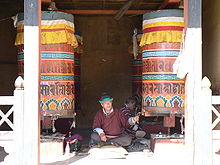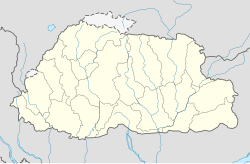Memorial Chorten, Thimphu
| Memorial Chorten | |
|---|---|
 National Memorial Chorten | |
| Religion | |
| Affiliation | Tibetan Buddhism |
| Sect | Nyingma |
| Deity | Jigme Dorji Wangchuck |
| Location | |
| Location | Doeboom Lam, Thimphu |
| Country | Bhutan |
| Geographic coordinates | 27°27′59″N 89°38′16″E / 27.46639°N 89.63778°E |
| Architecture | |
| Founder | Thinley Norbu |
| Date established | 1974 |
The Memorial Stupa, Thimphu, also known as the Thimphu Chorten, is a
This stupa is unlike others as it does not enshrine human remains. Only the Druk Gyalpo’s photo in a ceremonial dress adorns a hall in the ground floor.[2] When he was alive, Jigme Dorji wanted to build "a chorten to represent the mind of the Buddha".[4]
History
The Memorial Chorten of Thimphu was conceived by

Architecture

The architecture of the chorten has been designed to present it as “one of the most visible religious structures in Thimphu”.[2] The Memorial Chorten, in the heart of the city, is designed is a Tibetan style chorten, also called the Jangchup Chorten, patterned on the design of a classical stupa, with a pyramidal pillar crowned by a crescent moon and sun. The feature that is distinct here is the outward flaring of the rounded part to give the shape of a vase (a pyramidal shape), unlike a dome shape.[3][5] The chorten depicts larger than life size images of wrathful deities with their female consorts in large numbers, and many in explicit Yab-Yum sexual poses (one count puts the number of such images at 36).[6]
Exterior
The chorten is a large white structure with a golden spire crowning it and a smaller golden spire above the front porch. It is approached through a small garden and a gate decorated with three slate carvings. On the exterior of the gate are representations of the three protective
Interior

The chorten is decorated with richly carved annexes facing the four directions, and contain mandalas, statues and a shrine dedicated to the third king.
Religious practice and festival
The Chorten, held in great religious fervour, is circumambulated only in a clockwise direction (reciting prayers and whirling the large red prayer wheels), as is the rule for any religious structures in Bhutan.[2] The Monlam Prayer Festival is held here when the Je Khenpo (the religious head of Bhutan) addresses and blesses those who congregate for the occasion.[4]
References
- ^ a b c d e f g Pommaret, Francoise (2006). Bhutan Himalayan Mountains Kingdom (5th ed.). Odyssey Books and Guides. pp. 171–2.
- ^ a b c d e f g "National Memorial Chorten – Thimphu". Bhutan360.com. Archived from the original on 2011-07-07. Retrieved 2010-04-05.
- ^ a b Rennie & Mason 2008, p. 186.
- ^ a b c d "The National Memorial Chorten". Archived from the original on 2012-12-15. Retrieved 2010-04-05.
{{cite web}}: CS1 maint: bot: original URL status unknown (link) - ISBN 1-86450-145-6. Retrieved 2010-04-05.
- ^ Carpenter & Carpenter 2002, p. 142.
Bibliography
- Carpenter, Russell B.; Carpenter, Blyth C. (January 2002). The Blessings of Bhutan. University of Hawaii Press. ISBN 978-0-8248-2679-6.
- Rennie, Frank; Mason, Robin (2008). Bhutan: Ways of Knowing. IAP. ISBN 978-1-59311-734-4.

